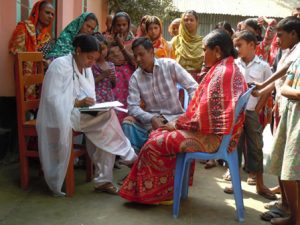COVID-19 in India: Immense Role for HealthCare Field Workers
Frontline health workers, Anganwadi and sanitation workers, with innovative tools and approaches, can amplify the fight against the COVID-19 pandemic in India.

On 30 March 2020, Prime Minister Modi met social welfare organizations and highlighted three distinct characteristics they have: ‘humane approach, massive reaches and connection with people of a service mindset, due to which they are trusted implicitly’. These specialities are crucial to delivering effective COVID-19 related behaviour change messages.
Frontline workers can reach poor households who require continued guidance and encouragement to adopt improved health-related behaviours. While unidirectional mass media campaigns and advertisements increase demand for products and knowledge, they fall short in addressing individual or community-specific concerns that hamper their ability to adopt improved behaviours. One-on-one discussions between household members and outreach workers lead to increased uptake of health interventions starting from antenatal care to vaccination. Community health staff (ASHA workers), early childhood caregivers (Anganwadi workers) and community-based NGO workers reach millions of people to provide critical services information about childcare, nutrition, antenatal care and family planning. These relationships are bolstered over years of personal conversations and guidance that allow respondents to ask and listen with their health and family in mind.
Also Read : Migrant Exodus During The National Lockdown
As the coronavirus (COVID-19) outbreak spreads through the country, fears about morbidity and mortality will consequently escalate in communities. Cities are experiencing mass exodus where migrant workers are returning to their native towns and villages. Missing the opportunity to answer relevant questions on everyone’s mind leads to noncompliance, misperceptions and misplaced faith in fake news. In the era of WhatsApp viral messages and videos, trusted social networks of informed community-based health workers are key to establish routes for reliable transmission of COVID-19 related facts and prevention messages.
In developed countries like the US, Italy and Spain, the healthcare systems are struggling under the burden of severe cases. Currently, India has reported over 1,000 cases and the government is mobilizing. While most have mild to moderate symptoms and recover without special treatment, many vulnerable groups such as the elderly or people with pre-existing conditions can develop severe disease and die (WHO,2020).
In India, where the burden of diabetes, hypertension, asthma and tuberculosis is high, the country should deploy every tool it can to contain this outbreak.

As India considers its COVID-19 containment plan, tapping into the massive pool of on-the-ground healthcare, workers will allow timely dissemination of useful messages. For example, if an Anganwadi worker from my community tells me to wash my hands, practise respiratory hygiene, stay at home and maintain a distance of 6 feet in public, I can follow up with questions about how to practise social distancing when we need to go out to buy food for the family. If someone in my family develops a cough and fever, having someone to call besides the village doctor might alleviate a wife’s or a son’s worries as he does not know how to isolate the patient in their small living space. Respiratory hygiene knowledge and practice are poor in low-income countries. Disruptions to daily livelihoods are causing economic hardship and distress among many. Having someone to call and talk about steps to take back control over their health and keep their families safe will be crucial. In addition, cases can be managed and triaged to appropriate healthcare services if existing networks are activated and reinforced.
How can we harness these frontline workers when COVID-19 mandates social distancing to reduce the person-to-person transmission? With the country in lockdown, health organizations and NGOs should assess ways to use information and communication technology (ICT) to activate and train their healthcare workers.
Also Read : Lack Of Rural Healthcare Story Of Bihars Phag
The high penetration of cell phones and wireless internet in low-income communities opens avenues for e-health and m-health, which refers to the practice of medicine and public health via mobile devices.
We should seriously assess the potential of using existing community healthcare workers as COVID-19 outreach workers who can disseminate health messages, illness knowledge, preventive measures and even organize endorsed videos. Indeed, group calls, WhatsApp messages, Facebook/Twitter live and reminders from them can open channels for conversations that can flag context-specific problems that need attention to cease community-based transmission. We should also consider asking community members to educate those in their networks with limited sources of information, that is, they do not have access to a smart phone or television to protect themselves and their families.
The Union Health Ministry (MOHFW) has timely released a toolkit to train frontline workers. (COVID-19 Facilitator Guide: Response and containment measures; Training toolkit for ANM, ASHA, AWW, 2020). This stands as significant training toolkit for frontline health workers.
In the upcoming months, the government and NGOs should plan to arm frontline health care workers and volunteers with personal protective equipment and empower them to disseminate messages and updates regarding the ongoing crisis. This will keep the community engaged, the health workers employed and utilize established relationships during this crisis. Frontline healthcare workers including sanitation workers, and those they serve, need government and NGO leadership and dedicated funding to support innovative approaches during this crisis.
